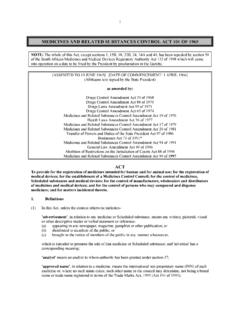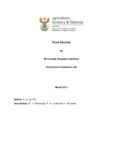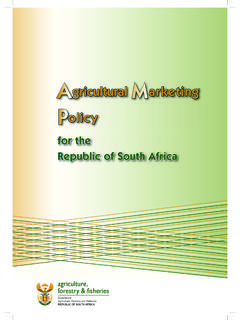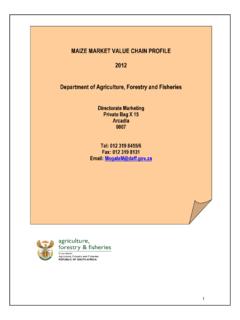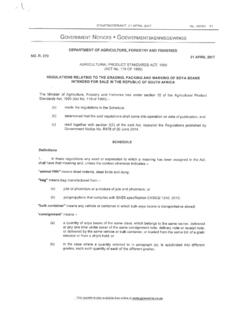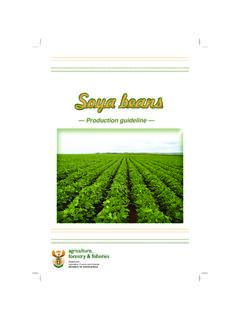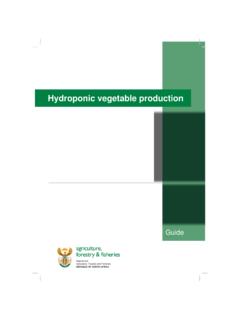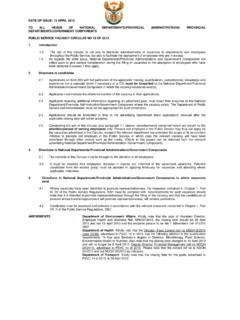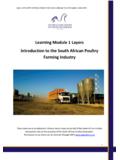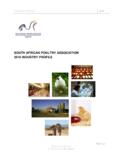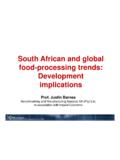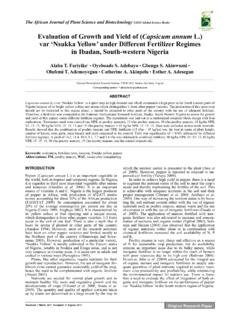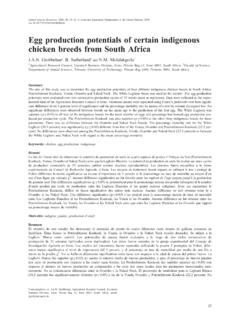Transcription of DRAFT DOCUMENT FOR A LIVESTOCK …
1 DRAFT DOCUMENT FOR A LIVESTOCK identification AND traceability system south AFRICA (LITS SA) 2 DRAFT DOCUMENT LITS SA Policy Structure Framework 2018 Prepared by: Animal Production, Health and Food Safety February 2018 Comments can be sent before 12 March 2018 to the following email: 3 DRAFT DOCUMENT LITS SA Policy Structure Framework 2018 INDEX 1. DEFINITION/ GLOSSARY OF TERMS/ ACRONYMS 2. INTRODUCTION 3. PROBLEM STATEMENT 4. VISION 5. OBJECTIVES OF THE POLICY 6. STRATEGY SIGNIFICANCE 7. POLICY OPTIONS 8. POLICY STAGES 9. LINKAGE TO OTHER POLICIES 10. COMMUNICATION PLAN 11. MONITORING AND EVALUATION 12. REFERENCE DOCUMENTS 13. POLICY OWNER/COORDINATOR 14. DOCUMENT INFORMATION 15. APPENDICES 4 DRAFT DOCUMENT LITS SA Policy Structure Framework 2018 1. DEFINITIONS/ GLOSSARY OF TERMS/ ACRONYM Definitions: Animal -means a mammal, reptile, bird or bee.
2 Animal health information recording -refers to the process by which indicators of the health status of animal populations and related data on prevention, surveillance and outbreak management are systematically collected, recorded, calculated and securely stored and made accessible to users as appropriate. Animal identification -means the marking of an animal, individually or collectively, by its group, with a unique individual or group identifier. Animal identification system -means an integrated platform inclusively hosting components such as identification of, owners, the person(s) responsible for the animal(s), animal lifecycle data, animal health status with respect to permanent disease control zones, movements and other records with animal identification . Simultaneous access to authorised users of the competent authority to an animal s individual lifecycle history via electronic medium.
3 Animal identification and registration -is a core functionality of an animal identification and recording system and covers both animal identification and animal registration. Animal keeper -is the person responsible for the day-to-day management of animals on the premises. Animal owner -is a person (physical or moral) who has a legal title or right to the animals regardless of whether he/she owns the premises on which the animals are kept. Animal recording -is a generic term that integrates animal identification and registration, animal traceability , animal health information and animal performance recording. Animal traceability -means the ability to follow an animal or group of animals during all stages of its life. By-products -in relation to slaughtered animals includes all portions of slaughtered animals other than the meat thereof. Captive Wild Animal -means an animal that has a phenotype not significantly affected by human selection but that is captive or otherwise lives under direct human supervision or control, including zoo animals and pets.
4 Dip tank mark -a mark allocated in terms of section 18 of the Animal identification Act, 2000 (Act 6 of 2002) that includes an alphabetical or numerical character to identify the Province and one to two alphabetical characters to identify the specific dip tank including the GPS co-ordinates. LITS SA -a LIVESTOCK identification and traceability system south Africa. LITS SA Committee -a body established that is represented by government and the LIVESTOCK Industry to implement LITS in south Africa as per Terms of Reference. Establishment - (also holding or property ) means any premises, structure, location or any environment, in which animals are kept, except for: (a) households keeping small companion animals; (b) non-commercial aquaria keeping aquatic animals. National mark -a mark allocated in terms of section 18 of the Animal identification Act depicting a three-legged pot to be used as prescribed in addition to the ZA embossed for all official tags and in addition laser marked on the ear tags and the ZAF for Foot-and-Mouth official tags.
5 5 DRAFT DOCUMENT LITS SA Policy Structure Framework 2018 Numerical character -a number between one and nine that forms part of a dip tank mark to identify a specific province in south Africa. A numeral mark will have a corresponding meaning to the numerical character. Manager -means a natural or legal entity, person, having animals and products under their responsibility, including a mandated animal keepers and transporters on behalf of the owner, but excluding pet keepers and veterinarians. Products of animal origin -means: (a) food of animal origin, including products that require veterinary certification, honey and blood; (b) live bivalve molluscs, live echinoderms, live tunicates and live marine gastropods intended for human consumption; and (c) animals other than those referred to in (b) destined to be prepared with a view to being supplied live to the final consumer.
6 Registration -is the action by which information on animals, products and establishments is collected, recorded, securely stored and made appropriately accessible and able to be utilised. traceability -the ability to verify a DOCUMENT , report, claim or statement that relates to the regulatory compliance or liability or movement, disease management, statistics and other market related history, location or application of an item via an integrated animal identification and traceability management platform. Transporter -means any person transporting animals on its own account, or for a third party; Wild Animal -means an animal that has a phenotype unaffected by human selection and lives independent of direct human supervision or control. Wildlife -means feral animals, captive wild animals and wild animals. 6 DRAFT DOCUMENT LITS SA Policy Structure Framework 2018 Acronyms.
7 AIRT Animal identification , Recording and traceability AIDA The Animal identification Act, 2000 (Act no 6 of 2000) DAFF Department of Agriculture Forestry and Fisheries ICAR International Committee for Animal Recording MPO Milk Producers Organisation NERPO National Emergent Red Meat Producers Organisation NSPCA National Society for the Prevention of Cruelty to Animals OIE World Organization for Animal Health (translated from the French) RMRDT Red Meat Research and Development Trust RMAA Red Meat Abattoir Association RPO Red Meat Producers Organization SAFA south African Feedlot Association SAFLA south African Federation of LIVESTOCK Agents SAMPA south African Meat Processors Association SAOBC south African Ostrich Business Chamber SAPPO south African Pork Producers Organization SAPS south African Police service SHALC Skins, Hides and Leather Council 7 DRAFT DOCUMENT LITS SA Policy Structure Framework 2018 2.
8 INTRODUCTION LIVESTOCK are farmed in solely LIVESTOCK producing areas as well as in conjunction with other mixed farming enterprises. Seventy percent of agricultural land in south Africa can be utilized only for LIVESTOCK and game production. In 2010, the SA LIVESTOCK population statistics estimated there to be million beef cattle, million dairy cattle, million sheep, million goats, 3 million game species (farmed), million pigs, 113 million broilers, million layers and million ostriches. At the end of August 2016, the total number of cattle in south Africa was estimated at 13,57 million, comprising various developed dairy and beef cattle breeds as well as indigenous breeds such as the Afrikaner, Bonsmara, Drakensberger and the Nguni. Beef cattle comprise approximately 80% of the total number of cattle in the country, while dairy cattle make up the remaining 20%.
9 There are various breeders organisations representing most developed and indigenous cattle breeds. Organisations are affiliated either to the south African Studbook and Animal Improvement Association, or to the LIVESTOCK Registering Federation (LRF). The Milk Producers Organisation (MPO) is the most prominent producer organisation in the south African dairy sector. The Red Meat Producers Organisation (RPO) and the National Emergent Red Meat Producers Organisation (NERPO) represent LIVESTOCK producers in the large commercial and small commercial agricultural sectors, respectively. The total number of sheep in south Africa at the end of August 2016 were estimated at 23,71 million, with the largest numbers of sheep estimated to be in the Eastern Cape (29%), Northern Cape (25%), Free State (20%) and Western Cape (12%) provinces. Flock sizes vary between less than 50 to 1 800 animals.
10 Sheep flocks in the Eastern, Western and Northern Cape provinces tend to be much larger than those in the other provinces. The animals are farmed mainly for wool and mutton production and the industry is therefore represented by organisations from the mutton as well as the wool industry. The sheep industry also has various breeders associations, with the Dorper Sheep Breeders Society of south Africa and Merino SA being the most prominent. Flocks of goats intended for meat production are usually smaller than sheep flocks, averaging approximately 300 goats per farm on the larger farms. Pigs are found predominantly in the Limpopo, North West, Gauteng and Western Cape provinces. There are approximately 400 commercial pork producers and 19 stud breeders in south Africa. As of August 2016, it is estimated that pig numbers have increased by 1,1%, to 1,540 million.
